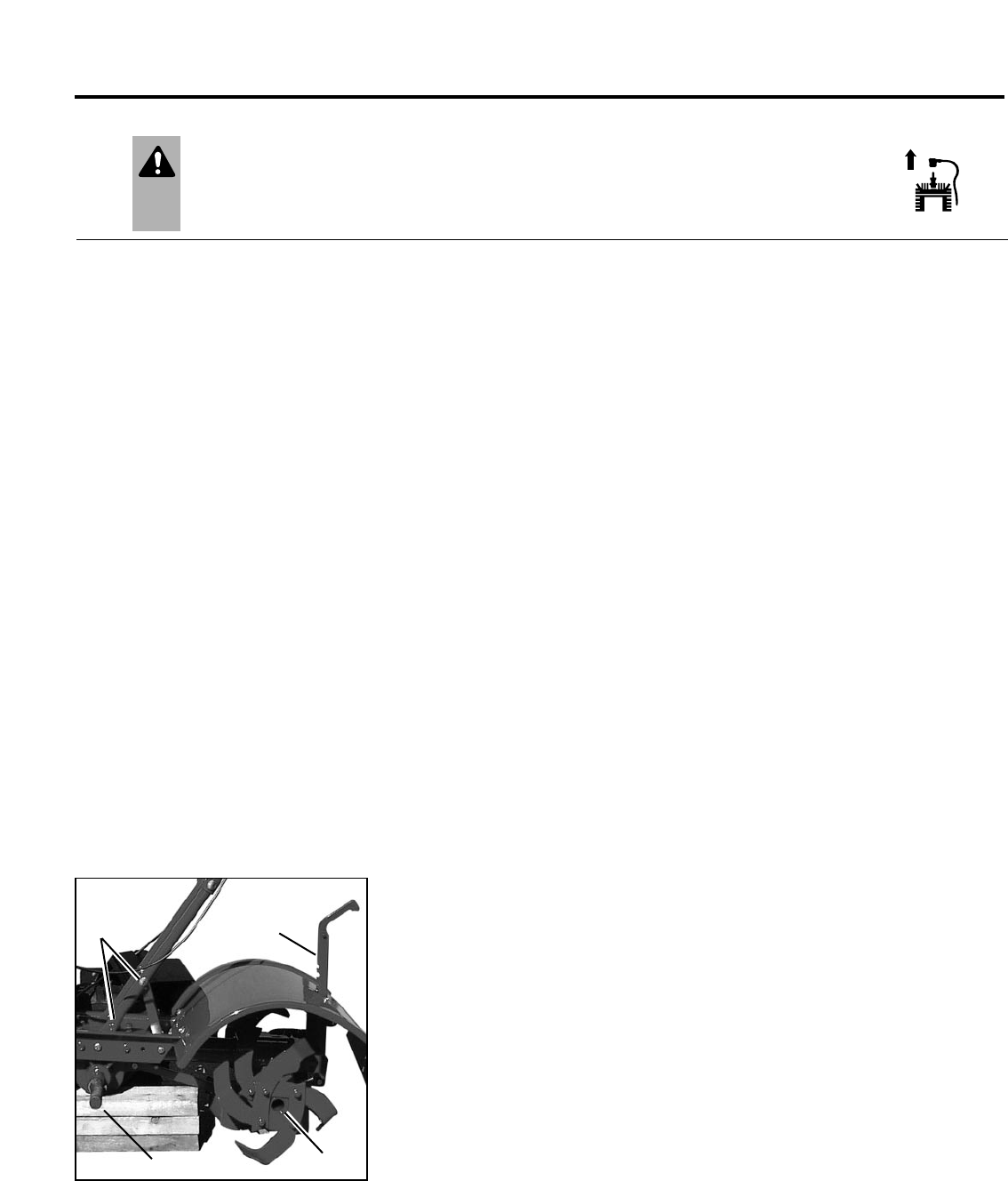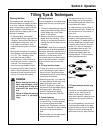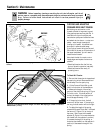
20
Section 5: Maintenance
TILLER LUBRICATION
Proper lubrication of the tiller is an
essential part of your maintenance
program. After every 10 operating
hours, oil or grease the lubrication points
shown in Figure 5-1 and described
below.
Use a good quality lubricating oil (#30
weight engine oil is suitable) and a good
quality general purpose grease (grease
that has a metal lubricant is preferred, if
available).
• Remove wheels, clean wheel shaft (A,
Fig. 5-1) and apply thin coating of
grease to shaft.
• Grease back, front and sides of depth
regulator lever (B, Fig. 5-1).
• Remove tines, clean tine shafts (C, Fig.
5-1) and inspect for rust, rough spots
or burrs (especially around holes). File
or sand smooth and coat ends of shaft
with grease.
• Oil the threads on the handlebar height
adjustment screws and the handlebar
attaching screws (D, Fig. 5-1).
TRANSMISSION GEAR OIL SERVICE
Check the transmission gear oil level after
every 30 hours of operation or whenever
you notice any oil leak. Operating the
tiller when the transmission is low on oil
can result in severe damage.
A. To Check the Transmission
Gear Oil Level:
1. Check the gear oil level when the trans-
mission is cool. Gear oil will expand in
warm operating temperatures and this
expansion will provide an incorrect oil
level reading.
2. With the tiller on level ground, pull the
Depth Regulator Lever all the way up.
3. Remove the oil fill plug (A, Fig. 5-2)
from the transmission housing and look
into the oil fill hole. You will see the main
drive shaft on one side of the hole.
4. The gear oil level is correct if the gear
oil is approximately halfway up the side of
the drive shaft.
5. If the gear oil level is low, add gear oil
as described next. If the gear oil level is
okay, securely replace the oil fill plug.
IMPORTANT: Do not operate the tiller if
the gear oil level is low. Doing so will
result in severe damage to the transmis-
sion components.
6. If adding only a few ounces of gear
oil, use API rated GL-4 or GL-5 gear oil
having a viscosity of SAE 140, SAE 85W-
140 or SAE 80W-90. If refilling an empty
transmission, use only GL-4 gear oil
having a viscosity of SAE 85W-140 or
SAE 140.
7. While checking frequently to avoid
overfilling, slowly add gear oil into the oil
fill hole until it reaches the halfway point
on the drive shaft.
8. Securely replace the oil fill plug.
CHECK FOR OIL LEAKS
Before each use, check your tiller for
signs of an oil leak – usually a dirty, oily
accumulation either on the unit or on the
floor where it has been parked.
A little seepage around a cover or oil seal
is usually not a cause for alarm. However,
if the oil drips overnight then immediate
attention is needed as ignoring a leak can
result in severe transmission damage.
If a cover is leaking, try tightening any
loose screws. If the screws are tight, a
new gasket or oil seal may be required. If
the leak is from around a shaft and oil
seal, the oil seal probably needs to be
replaced. See your authorized dealer or
contact the factory for service or advice.
IMPORTANT: Never operate the tiller if
the transmission is low on oil. Check the
oil level after every 30 hours of operation
and whenever there is any oil leakage.
CHECK HARDWARE
Check for loose or missing hardware after
every 10 operating hours. Tighten or
replace hardware before using the tiller.
Be sure to check the screws underneath
the tiller hood (lift the hood flap) that
secure the transmission cover and the
depth regulator lever to the transmission.
CHECK TIRE PRESSURE
Check the air pressure in both tires.
Deflate or inflate both tires evenly from
15-to-20 PSI (pounds per square inch).
Be sure that both tires have the same air
pressure or the unit will tend to pull to
one side.
Figure 5-1
A
B
C
D
WARNING Before inspecting, cleaning or servicing the unit, shut off engine, wait for all
parts to come to a complete stop, disconnect spark plug wire and move wire away from spark
plug. Failure to follow these instructions can result in serious personal injury or
property damage.


















